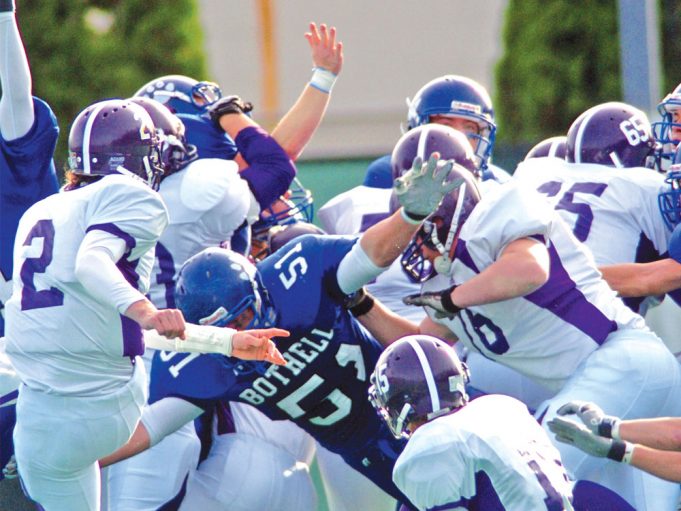When thinking of players associated with the kicking game, the usual focus is on those who kick the ball and team R players attempting to catch and return them. However, another participant involved with scrimmage kicks is the holder.
The rulebooks define the holder as the player who controls the ball on the ground or on a kicking tee (NFHS 2-32-7; NCAA 2-27-3b). While NFHS does not note when a player stops being a holder, NCAA notes that during a scrimmage kick, a player remains a holder until no player is in position to make the kick or, if the ball is kicked, until the kicker has had a reasonable time to regain his balance.
A holder is normally about seven yards deep in team K’s backfield for a kick try or a field goal attempt. He receives the snap and places the ball for the kicker so the kicker can boot the ball over the crossbar and between the uprights.
In NFHS, after controlling the snap, the holder can put the ball on a kicking tee or on the ground before a placekick is made (2-24-4). In NCAA, the ball must touch the ground; a tee is not allowed (6-3-10d). After receiving the snap, the holder places a finger or hand on top of the ball, then may rotate and/or tilt the ball to the kicker’s preferred position.
A team K member might also control the ball on the field surface or a tee before a kickoff is made. He is not encroaching (NFHS) or offside (NCAA) if he is beyond team K’s free-kick line in such a case. You might see that on a windy day when the ball blows off of a tee.
Holders have the same protections as kickers — they also cannot be run into or roughed. The penalty for running into the holder is five yards from the previous spot (NFHS 9-4-5; NCAA 9-1-16a-2). The penalty for roughing the holder is 15 yards from the previous spot and an automatic first down on field goals (NFHS 9-4-5; NCAA 9-1-16a-1).
If contact is caused by a team R player being blocked into the holder by a team K participant, that team R player is exempt from either foul (NFHS 9-4-5d; NCAA 9-1-16a-5).
When in doubt as to whether the foul is roughing or running into the holder, the more severe penalty should be enforced.
If a defensive player contacts the holder after touching the kick, he should not be flagged for either foul. However it is a foul when a player other than the one who blocks the kick runs into or roughs the holder (NFHS 9-4-5b; NCAA 9-1-16a-6 and 7). A rare occurrence is a holder committing an unsportsmanlike act for simulating being run into or roughed (9-1-16b).
While the holder’s knee is down in NFHS, he cannot control the snap and then throw a pass. Such action causes the ball to become dead immediately. If the holder rises, he can pass, run or hand off to another player. The ball remains live if the holder rises and catches or recovers an errant snap and immediately returns his knee(s) to the ground and places the ball for a kick or again rises to advance, hand, kick or pass (4-2-2 Exc.). In NCAA, if there is a player in position to kick, the holder can throw a forward or backward pass or hand off before rising (4-1-3b Exc.).
Play 1: Holder K1 receives the snap with one knee on the ground. The kicker pretends to kick but intentionally misses the ball. K1 stands up with the ball and runs into the end zone. Ruling 1: Legal.
Play 2: Slot back K1 goes in motion before the snap and runs behind the kicker and holder. After receiving the snap, the grounded holder flips the ball to K1, who catches the backward pass and crosses the goalline. Ruling 2: In NFHS, the ball is dead when the pass is made. Legal in NCAA.
The referee has primary responsibility to call fouls against the holder and to rule if the holder’s actions are legal or not. Although fouls against holders are rare, referees must be aware they have equal safeguards as kickers.
What's Your Call? Leave a Comment:
Note: This article is archival in nature. Rules, interpretations, mechanics, philosophies and other information may or may not be correct for the current year.
This article is the copyright of ©Referee Enterprises, Inc., and may not be republished in whole or in part online, in print or in any capacity without expressed written permission from Referee. The article is made available for educational use by individuals.


















